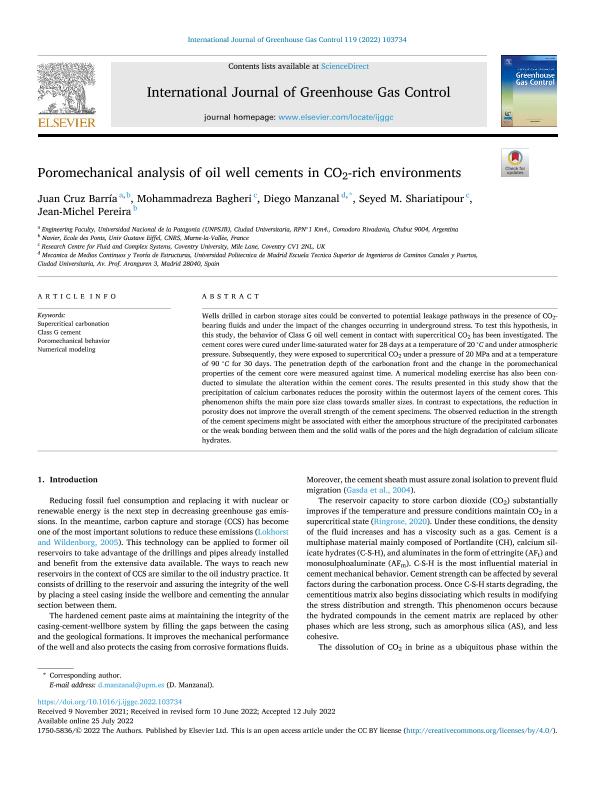Mostrar el registro sencillo del ítem
dc.contributor.author
Barría, Juan Cruz

dc.contributor.author
Bagheri, Mohammadreza
dc.contributor.author
Manzanal, Diego

dc.contributor.author
Shariatipour, Seyed M.
dc.contributor.author
Pereira, Jean Michel
dc.date.available
2023-07-06T17:41:36Z
dc.date.issued
2022-09
dc.identifier.citation
Barría, Juan Cruz; Bagheri, Mohammadreza; Manzanal, Diego; Shariatipour, Seyed M.; Pereira, Jean Michel; Poromechanical analysis of oil well cements in CO2-rich environments; Elsevier; International Journal of Greenhouse Gas Control; 119; 9-2022; 1-14
dc.identifier.issn
1750-5836
dc.identifier.uri
http://hdl.handle.net/11336/202633
dc.description.abstract
Wells drilled in carbon storage sites could be converted to potential leakage pathways in the presence of CO2-bearing fluids and under the impact of the changes occurring in underground stress. To test this hypothesis, in this study, the behavior of Class G oil well cement in contact with supercritical CO2 has been investigated. The cement cores were cured under lime-saturated water for 28 days at a temperature of 20 ∘C and under atmospheric pressure. Subsequently, they were exposed to supercritical CO2 under a pressure of 20 MPa and at a temperature of 90 ∘C for 30 days. The penetration depth of the carbonation front and the change in the poromechanical properties of the cement core were measured against time. A numerical modeling exercise has also been conducted to simulate the alteration within the cement cores. The results presented in this study show that the precipitation of calcium carbonates reduces the porosity within the outermost layers of the cement cores. This phenomenon shifts the main pore size class towards smaller sizes. In contrast to expectations, the reduction in porosity does not improve the overall strength of the cement specimens. The observed reduction in the strength of the cement specimens might be associated with either the amorphous structure of the precipitated carbonates or the weak bonding between them and the solid walls of the pores and the high degradation of calcium silicate hydrates.
dc.format
application/pdf
dc.language.iso
eng
dc.publisher
Elsevier

dc.rights
info:eu-repo/semantics/openAccess
dc.rights.uri
https://creativecommons.org/licenses/by/2.5/ar/
dc.subject
CLASS G CEMENT
dc.subject
NUMERICAL MODELING
dc.subject
POROMECHANICAL BEHAVIOR
dc.subject
SUPERCRITICAL CARBONATION
dc.subject.classification
Ingeniería Civil

dc.subject.classification
Ingeniería Civil

dc.subject.classification
INGENIERÍAS Y TECNOLOGÍAS

dc.title
Poromechanical analysis of oil well cements in CO2-rich environments
dc.type
info:eu-repo/semantics/article
dc.type
info:ar-repo/semantics/artículo
dc.type
info:eu-repo/semantics/publishedVersion
dc.date.updated
2023-07-06T14:40:00Z
dc.journal.volume
119
dc.journal.pagination
1-14
dc.journal.pais
Países Bajos

dc.journal.ciudad
Amsterdam
dc.description.fil
Fil: Barría, Juan Cruz. Universidad Nacional de la Patagonia "San Juan Bosco"; Argentina. Consejo Nacional de Investigaciones Científicas y Técnicas; Argentina
dc.description.fil
Fil: Bagheri, Mohammadreza. Coventry University; Francia
dc.description.fil
Fil: Manzanal, Diego. Universidad Politécnica de Madrid; España. Consejo Nacional de Investigaciones Científicas y Técnicas; Argentina
dc.description.fil
Fil: Shariatipour, Seyed M.. Coventry University; Francia
dc.description.fil
Fil: Pereira, Jean Michel. No especifíca;
dc.journal.title
International Journal of Greenhouse Gas Control

dc.relation.alternativeid
info:eu-repo/semantics/altIdentifier/doi/http://dx.doi.org/10.1016/j.ijggc.2022.103734
Archivos asociados
